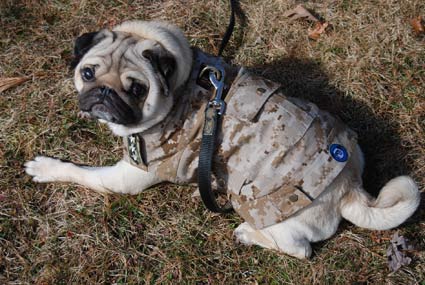Expert Tips for Finding Coats to Fit Your Dog
Published on January 25, 2013

Cold winter weather means you’ve probably got your winter coat out and ready for action. But what about your dog?
Not all dogs require coats for chilly temperatures, but for those who do need the extra warmth, finding the right fit can be a real challenge, especially when it comes to hard-to-fit breeds with large chests (like Bulldogs and Pugs). To get the scoop on how to find warm winter gear for these dogs, we turned to an expert: Angela Cuce, who, along with her husband, launched Cool Blue Dog Apparel, a company specializing in clothes for broad-chested breeds.
Q: What part of a dog is the most difficult to accommodate?
A: Angela Cuce, Cool Blue Dog Apparel: "By far, the chest (girth measurement)! That’s the main reason many dog manufacturers make jackets that close under the neck and under the belly, leaving the chest exposed. Meanwhile, it’s the chest and underbelly that require the most coverage in cold, wet weather. Most dogs’ coats are very sparse on the underbelly. That is also the body part closest to the cold, icy ground."

Q: What are the common problems arising from a poor fit?
A: "When shopping for dog clothes, most manufacturers’ size charts guide the shopper by weight and length. That’s fine if you have a dog with ‘perfect’ proportions, but how many of us do? … [A] 32-inch chest would equate to a length of about 22 to 23 inches, sometimes more. My dog, Bruiser, a 60-pound English Bulldog, is 16 inches long!
"Owners of Dachshunds have similar issues with length. Their weight and length are relatively disproportionate. Many owners of these dogs find a fit in the neck and chest, but as much as half of the dog’s body can be exposed as the coat is too short.
"Dogs come in all shapes and sizes, just like people. There needs to be more selection in the market."
Q: What’s the solution? Should people go up a size, or is that a problem in and of itself?
A: "Sometimes you can work around the issue. If you need to go up a size to accommodate a larger neck or chest, you may need to alter the length. It becomes more difficult, if the body of the garment overall is too big, to accommodate length. If you know how to sew, that’s great. We once spent $45 to hem a sweater for Bruiser that already cost $100! It can get expensive.
"One of [our solutions] is the use of a ‘belly belt.’ On the underside of our jackets and raincoats, we have a belt with Velcro that helps to cinch the garment for a more snug fit, if your dog has a smaller waistline, or leave it looser if the dog has a fuller figure. After all, you want the coat to fit underneath to keep out cold, wind and water.
"You may also want to consider a garment with less structure, like a sweater or hoodie. These styles usually have fewer seams. Fewer seams make for a less fitted garment and fuller cut."

Q: What tips can you offer people shopping for a coat for their dog, whether it’s a hard-to-fit breed or one that’s typically easy to fit? Are there certain measurements they should have on hand?
A: "Always have these three measurements: neck, girth and length. You will need at least two of the three, or all three, depending on the style. An idea of weight [could be helpful], but it’s not essential if you have the others.
"You should also look for the maximum amount of adjustability in the garment [like the aforementioned belly belt Cool Blue offers, which allows for an additional 1 to 2 inches on the underside of the jacket to help with fit]. It’s harder to manufacture a garment with full body coverage, but it’s the best for your dog. Anyone can make something that closes under the neck and under the belly, but that hinders the ability to keep the dog warm.
"Look for comfort, most importantly. Make sure the garment is a fabric that your dog will not want to rip off after a few minutes. Our jackets are made of cotton, some with a little stretch. Our linings are a soft fleece or mesh. Hoodies [are made of] a cotton/poly blend. Tank tops and dresses have 7 to 10 percent Lycra for stretch and comfort.
"Also make sure that the clothing fits correctly … to make relieving themselves easy and comfortable. Make sure the dog fits in the garment to make sure nothing is in the way, if you know what I mean. We — or really Bruiser — learned that one the hard way when trying out our first sample!"
More on Vetstreet:





